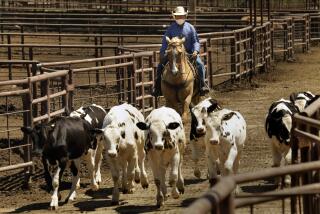Argentina Tries to Kick Beef Habit in Effort to Keep Economy Afloat
- Share via
BUENOS AIRES — Every year at about this time, Argentina’s heftiest livestock, thousands of pounds of world-class beef, goes on public display at the fairgrounds.
People dine there on tasty steaks, served on linen-covered tables placed in easy view of stalls of lounging Hereford, Charolais, Shorthorn, Fleckvieh, Santa Gertrudi and Aberdeen Angus.
It is a total immersion in meat, an Argentine’s means of having his beef and eating it too. It is also a symbol of something this historically great cattle country can no longer afford.
For decades, people here have enjoyed succulent beef, bred on the temperate plains of the pampas and sold at bargain prices--less than half that in the United States.
Development Choked
Ample quantities of inexpensive cuts became a mainstay of the social order. Beef profits financed growth and nurtured Argentina’s dreams of grandness. But this enormous appetite for meat has gradually come to choke national development. Authorities now say that unless Argentines start consuming less beef, the country could well eat itself broke.
“Unless we get out of our traditional eating patterns, we’re condemned to be poor,” said Segundo Acuna, professor of agriculture at the Catholic University in Buenos Aires.
President Raul Alfonsin agrees. Touring the giant livestock show here earlier this month, the Argentine leader urged his countrymen to diversify. “We are eating too much meat,” he said, observing that “it continues to be more comfortable and practical here to place a steak on the grill.”
Argentines hold the world title for beef consumption, at 175 to 220 pounds per year per person, twice the U.S. rate. They eat 27 pounds of poultry, 14 pounds of pork and 5.5 pounds of fish.
Prices Kept Low
Alfonsin said he would like to see beef consumption drop to 110 pounds per person. But his and previous governments have traditionally encouraged heavy beef eating by helping to keep meat prices low.
Too low, say cattlemen, who blame a gradual reduction in the herd--from 61 million head in 1977 to 52.5 million last year--for a squeeze on profits.
This dwindling stock, together with continued high domestic demand, has meant less meat for export. Less than 10% of the total slaughter now earns the foreign revenue that debt-burdened Argentina desperately needs. Industry experts predict that by the 1990s, it may have to import beef.
Conceivably, the Alfonsin government could reduce domestic demand and spur ranchland investment by allowing meat prices to rise. But this would be politically unpopular.
Government Motto
“Cheap meat, happy people--that’s been the motto of governments here for years,” said professor Acuna, himself a cattle owner.
Also, since beef constitutes such a significant share of household budgets, higher beef prices could wreck the government’s anti-inflation program. Fluctuations in beef prices drastically affect the cost of living, interest rates and black-market dollar exchange rates.
A 41% increase in meat prices last month, for instance, was cited as a major contributor to July’s 10.1% jump in the cost of living, the largest monthly increase since the start of the anti-inflation Austral Plan two years ago. Officials blamed the climb in beef prices on heavy rains, which interfered with market deliveries, and “pranks,” or speculative buying.
“In general, the government feels, ‘Don’t mess with beef,’ ” said Jacques Badin, president of a supermarket chain.
‘Meatless Days’ Tried
Cattlemen nonetheless have been pushing the government to permit higher prices, which would make investment in beef production more attractive. Officials agree that something must be done to curb beef consumption but doubt that a short-term answer can be found.
Past administrations have tried various schemes, including “meatless days,” which merely drove shoppers to hoard beef on days it was available. Black-market trading also flourished.
“The only solution,” said Ernesto Figueras, secretary of agriculture, livestock and fish, “is to diversify diets so the substitutes for beef can improve their stocks and thereby compete for consumption in a more stable framework.”
In fact, the faint outlines of an eating trend away from beef are already evident here.
Vegetarian Restaurants
Vegetarian restaurants are peeking out around the edges of this city’s crowded neighborhoods of barbecue pits and steak houses. In six years, such un-Argentine eateries have multiplied from three to more than 30.
There are other tentative signs of a retreat from meat. Supermarkets report mounting sales of fruits, vegetables and health foods. Books on natural foods top best sellers lists. A main newspaper here, La Nacion, recently published a two-part series chronicling the spread of vegetarian meals.
The new vegetarianism reflects a growing interest in physical fitness and heightened concern about meat’s cholesterol content. Many of the clientele are young urban professionals tuned into international trends and more inclined than older generations to break with traditional patterns.
More to Read
Sign up for Essential California
The most important California stories and recommendations in your inbox every morning.
You may occasionally receive promotional content from the Los Angeles Times.













